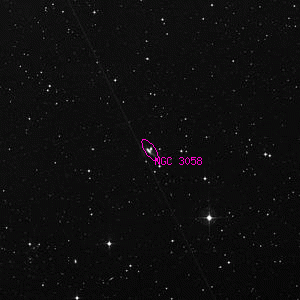NGC 3058

Overlaid DSS image of NGC 3058, 30' x 30' with north at top and west to the right
Aladin viewer for the region around NGC 3058
IC 573, MCG-02-25-026, VV 741, PGC 28513
| Type | Galaxy |
|---|---|
| Magnitude | 15 |
| Size | 2.5' x 1' @ 35° |
| Right Ascension | 9h 53' 36.2" (2000) |
| Declination | 12° 28' 56" S |
| Constellation | Hydra |
| Description | eF, pL, D or biN |
| Classification | SBc |
Observing Notes
Harold Corwin
IC 573 = NGC 3058s? The NGC position is again off in RA (but note Howe's correction in an IC2 note), but the description is accurate as is the NPD. Javelle could not have been aware of Howe's correction which was published after Javelle's first list. Javelle's place precedes the galaxy by about 3.5 seconds (an unusual error to make) and his declination is more appropriate for NGC 3058n. If we assume he saw the larger southern object, his "vS * close" is probably NGC 3058n.
Looking at this again in July 2018, I am no longer sure that Javelle's object is the larger, brighter, southern galaxy of the pair. His RA is just 1.4 seconds of time west of the fainter NGC 3058n with a nearly identical declination; his description 'Extremely faint, round, 10" in diameter, difficult, near a very small star' fits the northern object better. Given the disturbed nature of the pair, it could be possible that his "very small star" is actually the partially hidden nucleus of the southern galaxy.
However, Steve Gottlieb's observation of IC 573 reads:17.5" (4/15/93): faint, fairly small, round, low even surface brightness. A mag 13 star is 1.0' W. A wide mag 12/13 pair at 45" separation lies 2' SSW and a mag 12/13.5 pair at 30" separation E-W lies 3.5' W.He simply makes Javelle's object identical with NGC 3058 without specifically mentioning either the northern or southern components. His description also strongly suggests that the two were not separated in his eyepiece view. His description of the star field around the galaxy is very accurate, though, and further suggests that Javelle's "very small star" could well have been the 13th-magnitude star one minute west that Steve noted.
Herbert Howe did see both objects. His observation (from MNRAS 60, 130, 1899) with the 20-inch Chamberlin Observatory refractor is closer to the pair's appearance in the sky survey images:The following nucleus is the brighter. The preceding is at 210°, 20". The position of the brighter nucleus is 9h 48m 44s, -12° 0'.7.His position for the southern object is very good.
It's obvious that Javelle's observation does not give us enough information to decide which galaxy he saw. Given that the observations I've seen are not diagnostic, either, I'm simply going to adopt Steve's solution, letting IC 573 be identical to NGC 3058.
Other Data Sources for NGC 3058
Nearby objects for NGC 3058
Credits...
Drawings, descriptions, and CCD photos are copyright Andrew Cooper unless otherwise noted, no usage without permission.
A complete list of credits and sources can be found on the about page
NGC 3058